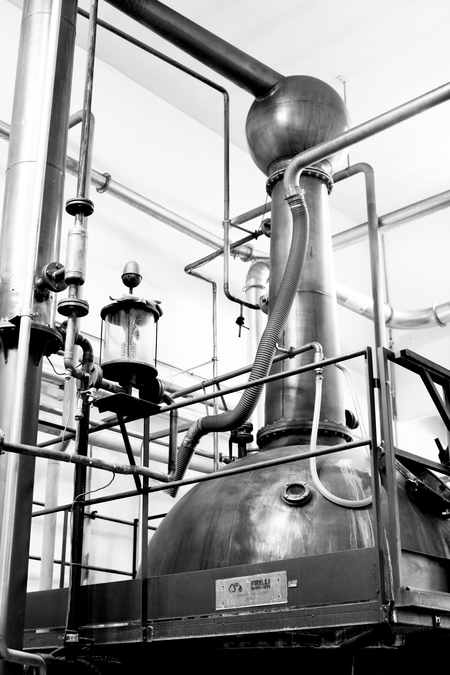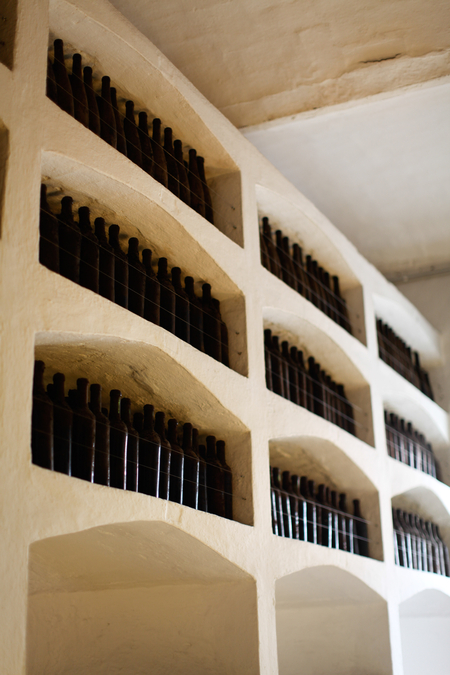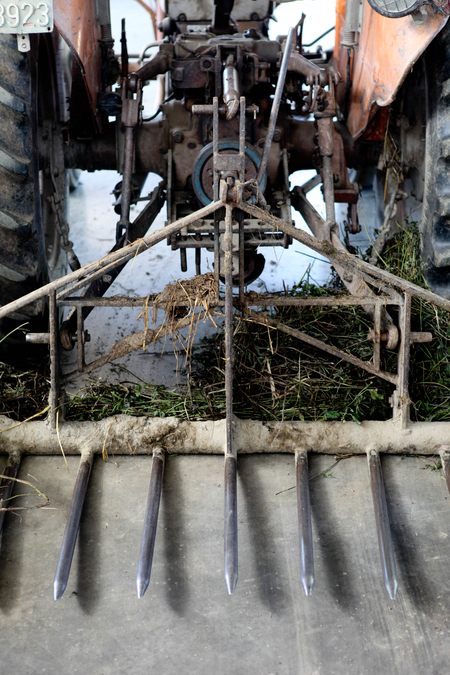Are you a Discerning Drinker?
Join thousands of like-minded professionals and cocktail enthusiasts, receive our weekly newsletters and see pages produced by our community for fellow Discerning Drinkers.
More about Martini & Rossi S.p.A.
Established: 1864
Owner: Bacardi Limited
Capacity: Not supplied
Visitor Policy: Visitors welcome throughout the year
Tel: +39 011 9419 1
Website: http://www.martini.com/
Address
Chieri-Pessione
10023
Torino
Italy
All Martini vermouths are made from a blend of wines, flavoured with botanicals (leaves, flowers, fruits, seeds, roots and barks) whose properties have been extracted by maceration in ethyl alcohol, with the result of some macerations also distilled.
While the processes are largely common knowledge, the secret 1863 formula for Martini Rosso is known to only four individuals, as are the later recipes for Extra Dry, Bianco and Rosato. The original recipes are kept under lock and key in a bank vault in Geneva. The skilled aspects and what make Martini special are sourcing quality wines and botanicals, using various processes to extract flavours from the botanicals, and blending all the components together harmoniously.
Martini vermouth is still made in Pessione, at the same site Alessandro Martini and Luigi Rossi established in 1864. When the partners started building, Pessione was a small village, but now it has grown into a town with the majority of its inhabitants working directly or indirectly for Martini. The plant has also grown with building-after-building now occupying a vast site and more than 300 people employed on production alone. Modern, state-of-the-art blending facilities sit next to 19th century buildings, creating a feeling of a town within a town.

The street that runs with the plant
The word ‘vermouth’ actually comes from the German word ‘vermut’, meaning ‘wormwood’ – the name of the legendarily bitter plants in the Artemisia family typically associated with absinthe, and used for its bitter character since Roman times. Martini use a combination of two different types of Artemisia varieties (and three for Riserva Speciale): a lighter, more delicate variety, and also a more fragrant style – neither, by the way, being the type of wormwood used in absinthe. Both varieties of Artemisia are grown close to Pessione, and are blended together to ensure greater complexity.
Dittany (Origanum dictamnus), is grown high in the mountains of Crete. The Ancient Greeks believed it to be a magical herb, and valued it for its supposed aphrodisiacal values as well as medicinal properties. Dittany delivers a complex herbal aromatic character to Martini.
A wide variety of flowers are used to add light, fragrant and fresh flavours to Martini. These include rose, violet and Roman chamomile. The young flowers are picked by hand and gently dried to preserve their fragrance. The Rosa Gallica (Red Provins Rose) are sourced from Morocco. These were widely cultivated by the Romans to be floated in baths, wine and decorations. Viola Odorata, or “Sweet Violet” comes from Italy.
The essential oils from the peels of citrus fruits play an important part in Martini vermouths. For that reason, very specific varieties are used: The Spanish ‘Citrus Limonum Risso’ lemons have low acidity and a sweet character while Tunisian Citrus Aurantium bitter oranges yield an intensive bitter orange note. Spanish lemon fruits are hand-picked and hand-peeled, with the peels hung on lines to dry in the sun, during which time they lose two-thirds of their weight.
Soft fruit contributes delicate high aromatics to Rosato and Extra Dry, with some of the botanicals distilled rather than just macerated to best extract the subtlest top-notes. Raspberries are one such fruit and these are sourced only from producers who can guarantee their freshness and quality. They are harvested with care in order to do not damage the fruit and macerated in pure grain alcohol prior to distillation in one of a pair of English pot stills at Pessione.

Pot stills at Pessione
Two rare woods from the Caribbean are important to Martini’s flavour profile. Cascarilla Bark, also known as ‘Sweet-wood’, comes from the Bahamas: it was used for many hundreds of years to make an aromatic tonic. The cut bark is washed in sea water and dried on the beaches, giving it a hint of sea-air. The other, Quassia wood, is gown in the hill forests of Jamaica and is nicknamed ‘bitterwood’ due to being one of the most bitter substances in nature. Traditional religious healers used the wood to make remedies – they believed that a single knife had to be used to cut the wood into chips and if lost then the Quassia would no longer yield its woods special properties.
Various roots are also the source of important botanicals. Orris oil is extracted from the roots of the Florentine iris and Master Herbalist, Ivano Tonutti believes the finest is cultivated in Tuscany. It takes a long three years to dry and mature the root before the essential oil is of sufficient character to give the desired light fragrant note of fresh violets. Gentian root from the Great Yellow Gentian, cultivated in the high mountains of Puy de Dôme in France’s Massif Central, is hand-cut and brings a subtle bitter herbal character as well as boasting numerous medicinal properties.

Master Herbalist, Ivano Tonutti
Luigi Rossi used exotic spices which the great Venetian and Genoese merchants brought to Italy such as fragrant young cloves from Madagascar and Ceylon or ‘True’ Cinnamon from Sri Lanka. Its smooth, thin bark provides a highly fragrant aromatic spice that underlies several of Martini’s vermouths.
Every botanical received at Pessione is checked for its quality in the intriguing-sounding Aroma Room. The botanicals vary with each harvest and Ivano’s check both the quality and character to insure they remain faithful to Martini’s formulation. Over 500 of the best botanicals are retained as samples each year as a benchmark for the quality of stocks in subsequent years.
The Martini flavour is extracted from the botanicals through maceration in alcohol and, in some cases, also distillation. This is different to Bacardi’s other vermouth brand, Noilly Prat, where botanicals are steeped in the wine rather than alcohol. It is the secret and complex processes used to extract and combine aromatic herbs, scented flowers, fragrant fruits, exotic woods and rare roots that separates one vermouth from another. It is worth mentioning that Ivano is responsible not only for overseeing botanicals at Martini and Noilly Prat, but also for Bombay Sapphire: he truly is one of the most experienced herbalists in the world.
One of the many processes used to capture the botanicals’ aromatic essence is the ‘tamburo’ – a huge cylindrical vat which very slowly turns a blend of botanicals in natural alcohol, making only two rotations a day. Any faster would impart overly bitter characters, so this stage of the process takes two to four weeks.
Martini has contracts with wine makers and cooperatives to produce the specific white wines required to make its vermouth. Luciano and his team all come from Alba, the Piedmontese capital of wine-making, which is considered to be one of the leading centres of oenology in Europe. Their task is to assess, select and blend the wines that will provide the body for Martini and allow the precious botanical characteristics to shine.
Known as ‘Vino Fiore’, the wines used come from the first gentle pressing of mainly Trebbiano and Catarratto grapes grown in Emilia, Romagna, Puglia and Sicilia, selected wines for their lightness, freshness and balance.
Blending and finishing occurs in a huge building known mysteriously as ‘Department 54’. This is where high-tech equipment is used to monitor and slowly blend the various ingredients in the precise order and quantities required without the use of pressure or heat. Once the perfect marriage between wines and botanicals is achieved, pure natural alcohol is added to preserve the botanicals and natural sugar for balance. The blend is then rested, during ‘Il Riposo’ as they call it, in order to allow it to marry and for any sediment to settle. Nicknamed Manhattan, due to the towering vats, the resting room holds 5.6 million litres of vermouth.

huge staniless steel vats in Manhattan
Finally the vermouth is chilled to -8°C in ‘Il Frigo’ – no translation needed – and is then held at this temperature for three to four days. This encourages mineral salts in the vermouth to settle so clarifying the vermouth so only a gentle chill filtration is required prior to bottling.

chill filtration
Each vat in ‘Manhattan’ holds 200,000 litres and the equivalent of two of these are bottled every day – at a rate of 20,000 bottles per hour – on each of the five lines. That’s a staggering volume, especially when you consider that Martini also has similar production plants in Spain, Brazil, Chile and Uruguay – Pessione ‘only’ produces around 70 per cent of the 16 million cases of vermouth that Martini sells worldwide each year.










































































